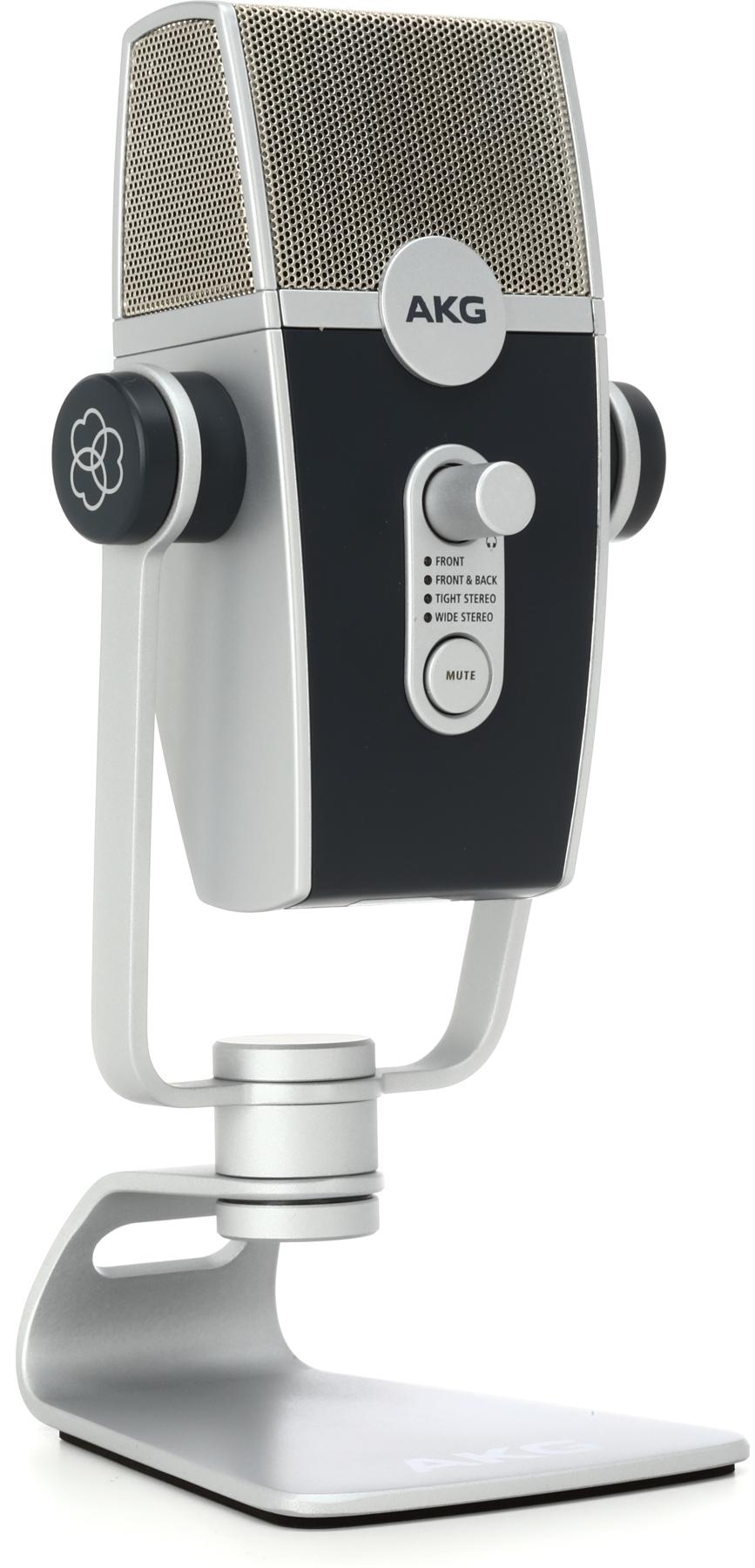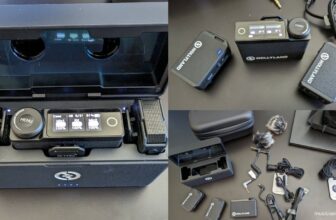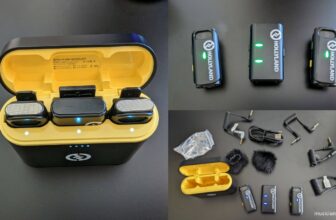AKG Lyra Review – Is It Worth It?
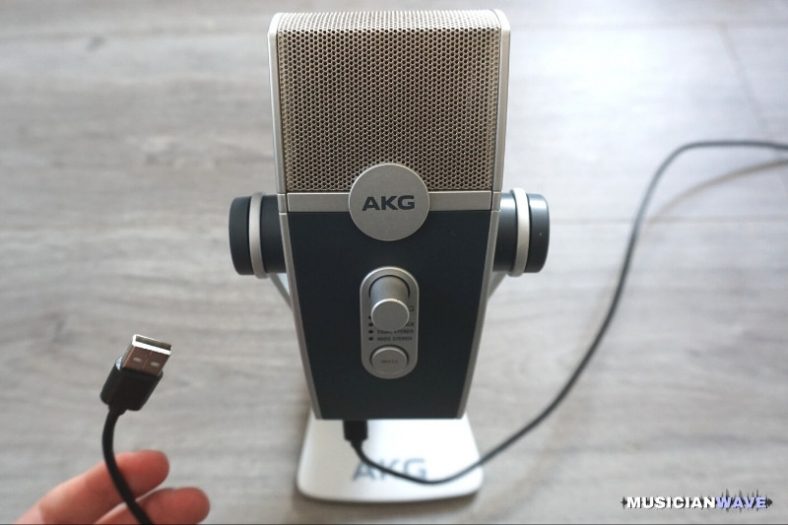
I’ve recently been putting the AKG Lyra USB condenser microphone to the test. It’s quite a versatile microphone that has surprisingly good sound quality for a microphone in its class and price range.
USB mics are an easy solution for podcasters, vloggers, streamers, gamers, and musicians that want decent-quality sound recording. The plug-and-play approach to these USB mics are favored by many as they don’t require audio interfaces or USB-mixers like regular XLR mics do.
AKG sent us a free sample of this microphone in order for us to test it out and review it. This will not affect the opinions mentioned in this review.
Contents
AKG Lyra
Verdict
The AKG Lyra is a very decent and well-designed USB condenser microphone for its price. It's quite versatile and features great specs. If you’re ok with it picking up a bit of background noise then it’s a very solid option to consider.
Pros
- 4 capture modes (front, front & back, tight stereo, wide stereo).
- Very decent sound quality
- Plug-and-play with USB-C connection (included cable is USB-C to standard USB-A)
- Nice design
- Small stand included, and it can also alternatively be mounted on a mic stand.
Cons
- As it’s a condenser mic, it picks up background noise.
- Mic pattern and volume gain dials placed on the back (a little inconvenient)
The sensitivity and multiple polar patterns of the AKG Lyra can be very useful. For example, you can be relatively far away from the mic when speaking (much further in comparison to dynamic mics). It can also quite easily pick up multiple people speaking when using its ‘wide stereo’ capture mode.
On the other hand, it picks up quite a lot of background noise, even when using the most restrictive ‘front’ pattern, mainly due to the fact that it’s a sensitive condenser mic. Therefore if you’re recording in a room with poor acoustics or noise then this will certainly come through in the recording. Noise from your keyboard, mouse, table, and speakers are all going to be picked up quite a bit.
The AKG Lyra microphone has very decent specs, a wide frequency response, four switchable capture modes, and overall great depth. It’s great for capturing spoken word, while also being a very decent mic for recording music for those on a budget.
In this article, I’m going to explain a bit more about my experience with using the AKG Lyra, and I’ll also compare it against alternative microphones.
First Impressions
First and foremost, this is a plug-and-play USB mic which is very handy to use as there is no need for a separate audio interface. It uses a USB-C connection which is an advantage (the included cable is USB-C to USB-A).
It was extremely well-packaged in its box, which is good to see for a condenser microphone, as these tend to be a bit more fragile in comparison to dynamic microphones.
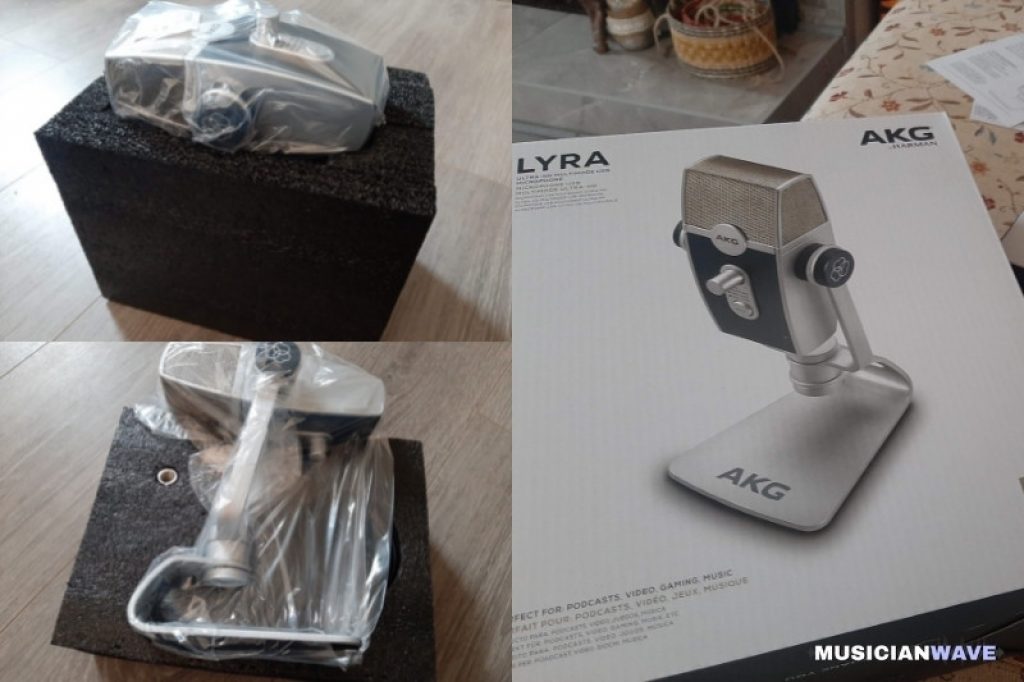
The AKG Lyra is a simple enough condenser microphone compatible with a wide range of devices. It’s got a kind of retro feel to it with a sturdy construction and a metal screen head.
The plastic buttons are extended forward and a bit wobbly, but they are adequate for the job. Four lights represent the different capture modes as well as the added mute button.
By default, the mic is attached to a sturdy base and it’s easy to adjust the angle of the mic. You can alternatively take this off and attach the mic to a stand or boom-arm.
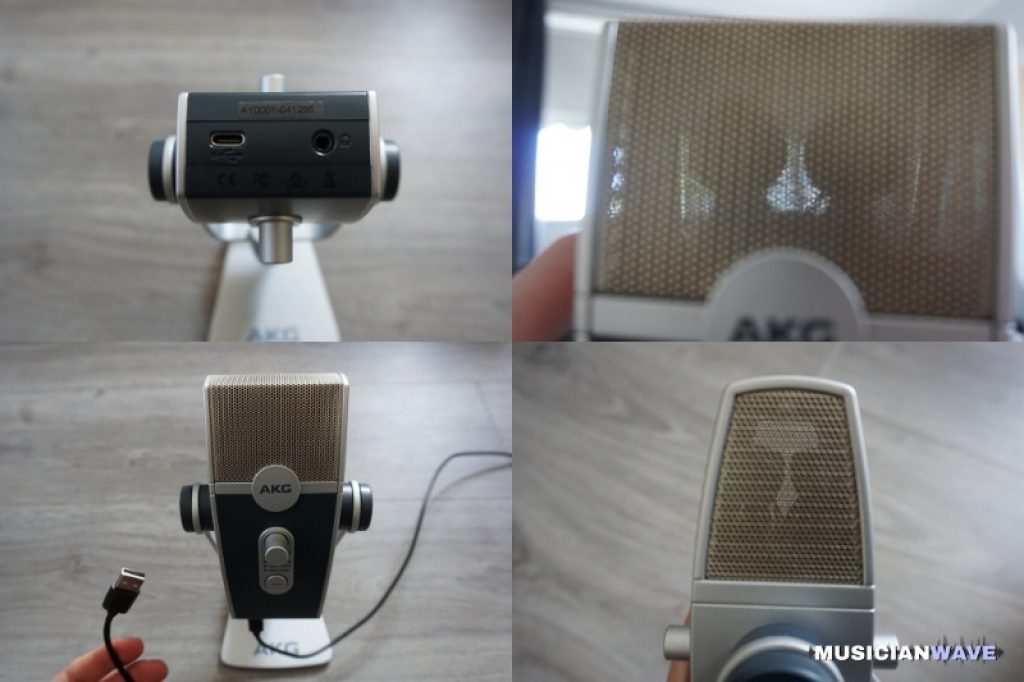
Features
The AKG Lyra has 4 buttons. On the front, you have a headphone volume control and a mute button. On the back, you have the polar pattern selection dial and a mic gain dial.
On the bottom of the AKG Lyra, there is a USB-C port and a 3.5 mm headphone jack. It also comes with an integrated (detachable) desk stand, but the mic can also be mounted on a boom arm or regular mic stand if necessary.
Sound
The AKG Lyra has great flexibility and sonic capabilities with the four different polar patterns (capture modes) that include Front, Front & Back, Tight Stereo, and Wide Stereo. So, depending on what you’re using the microphone for, these 4 polar patterns should suit most of your needs.
Overall, it records sound very nicely and from my tests, it didn’t pick up unwanted plosive sounds unless I was right up against the microphone.
Its most notable polar pattern, the ‘Front’, is generally the best option to go with if you want the cleanest sound as it eliminates unwanted background noise and provides a clear audio recording. This would generally be the most suitable for podcasters, streamers, and voice-overs.
It has a 24-bit depth as well as a 192 kHz sample rate which is impressive. The sound is either on par or better than most quality USB mics.
The ‘Front’ captures sound from only the front of the microphone while greatly reducing audio from both the sides and back. It is great for solo recordings or single-voice purposes like streamers, gamers, and voice-overs.
The ‘Front & Back’, as the name suggests, picks up the sound from both sides. This is a great option for podcasts and interviews which is great if you want a natural one-on-one conversation going.
The ‘Tight Stereo’ uses a two-microphone-capsule for recording instruments or performers positioned in front of the microphone. It would be a useful natural stereo recording option for musicians.
The ‘Wide Stereo’ offers a very wide capturing of stereo sound for ambient recording sessions with a much more detailed stereo depth. It’s also useful if you want to pick up sounds all around the room, such as if you have multiple people speaking around a table.
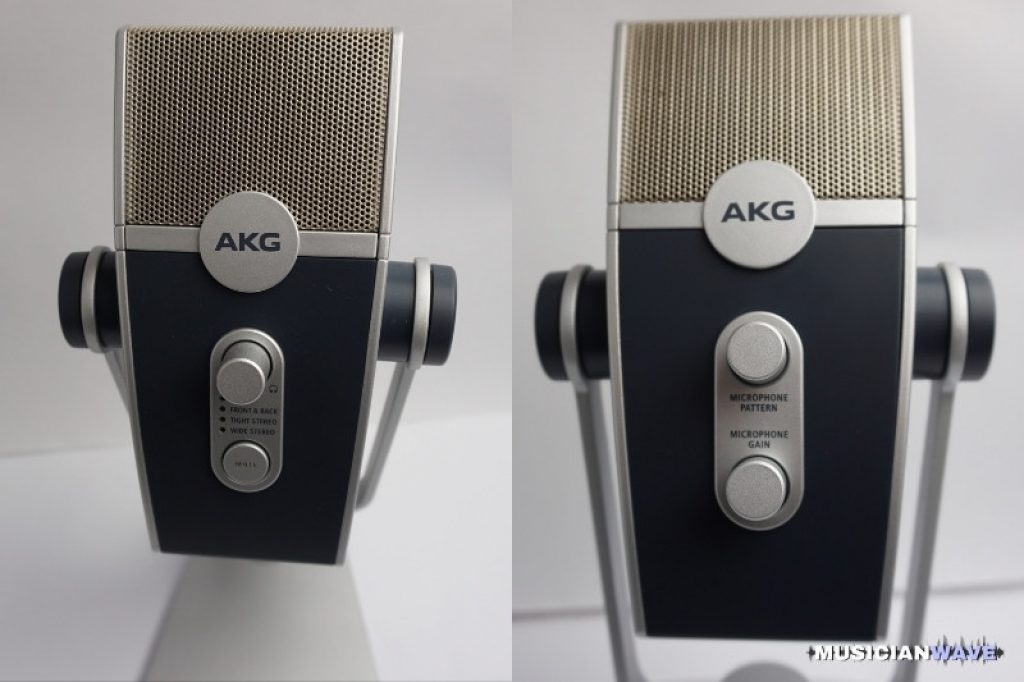
Differences Between the AKG Lyra and Ara
The AKG Lyra is a better microphone in comparison to the AKG Ara, and there is generally not a massive difference in price, so I would recommend getting the Lyra if you can.
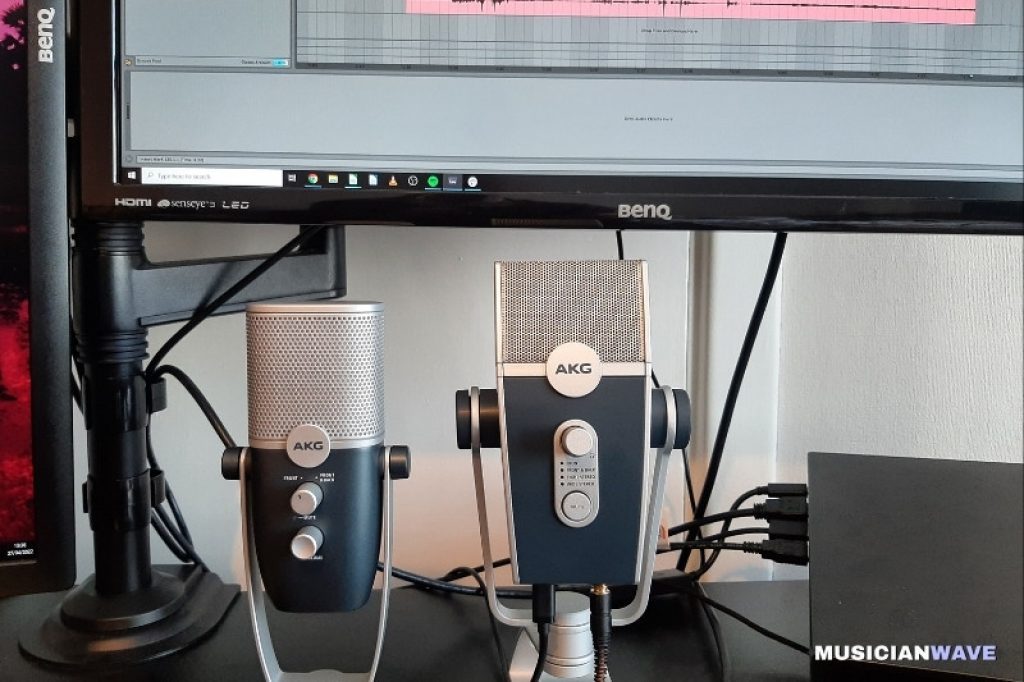
AKG also has a smaller and cheaper USB mic known as the AKG Ara. The obvious differences are in size as well as the capture mode selections.
The AKG Lyra has 4 polar patterns while the AKG Ara has 2 (only Front, and Front & Back), so the AKG Lyra is more versatile right off the bat. The AKG Ara also doesn’t include a gain knob, though you can increase the gain in your recording software if necessary.
The sound quality of the AKG Lyra is certainly better than the AKG Ara, but the differences are not as noticeable when speaking within a reasonable distance to the front of the mic. However, AKG Lyra’s multiple capture modes makes it far better at recording multiple people or at greater distances from the mic, and the AKG Lyra’s superiority is also a lot more evident when recording music.
That said, the AKG Ara is a little more portable and it includes less controls, which might make it easier for some people.
Other Alternatives to the AKG Lyra
I feel that the AKG Lyra sounds better than the popular Blue Yeti microphone. However, both of these are in the same class of USB condenser microphones, and these will pick up quite a bit of background noise simply due to their sensitivity.
However, both mics greatly benefit from the standard ‘cardioid mode’ on the Blue Yeti or ‘front’ on the AKG Lyra. These reduce background noise coming from behind the mic. For narrow directionality and single-voice purposes, they are both good options.
If you are going to be recording spoken word in an environment with bad acoustics or background noise, then I’d recommend picking up something like the Rode Podmic XLR dynamic microphone along with a decent audio interface, but you’ll need to be a lot closer to the mic for it to pick up good audio (which might or might not be suitable for your recording needs).
Drawbacks
The AKG Lyra is a very decent USB condenser mic from a great brand. There are a few things that I didn’t like about it though.
Naturally, the biggest drawback is that it captures a lot of unwanted background noise. This is a condenser mic and naturally, it will pick up a lot of unwanted and unnecessary audio. Its front capture mode negates this a little, though it’s still going to pick up quite a bit of background noise.
Another small hiccup for me is that the volume gain and microphone pattern dials are at the back of the microphone. Personally, I don’t like reaching back to set the gain or polar pattern (particularly as you might adjust the wrong one by mistake), I think it would have been a bit handier to have them placed on the front instead of fumbling around or having to turn the mic around to optimize it. Though perhaps they deemed that it would complicate the front controls of the mic a bit too much.
Software
The AKG Lyra works right out of the box, so you can use it with any recording or streaming software you like. Mine also included a serial code for Ableton Live 10 Lite in the box, which is an absolutely amazing piece of DAW software (used for recording audio and producing music) and good for basic use, though its certainly very limited in comparison to the paid versions of Ableton Live.
Specs
The AKG Lyra has some impressive specifications. Granted, there are more budget-friendly options for USB mics out there, but the AKG Lyra is still a very reasonable bargain, especially with the given specs:
Frequency Response: 20 Hz – 20 kHz
Polar Patterns: 4 polar patterns – Front, Front & Back, Tight Stereo, and Wide Stereo
Bit Depth: 24-bit
Sample Rate: 192 kHz
Maximum SPL: 129 dB SPL
Power Requirement / Consumption: 5V USB / 74 mA
Verdict
Overall, the AKG Lyra is a very decent USB mic with a very nice design. This mic performs very well, with great flexibility for recording on a budget. However, if you’re considering picking up a condenser mic like this, remember to keep the potential issues with background noise in mind.


